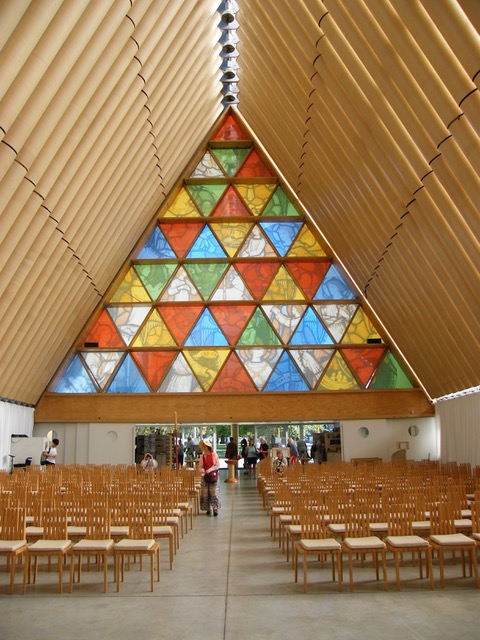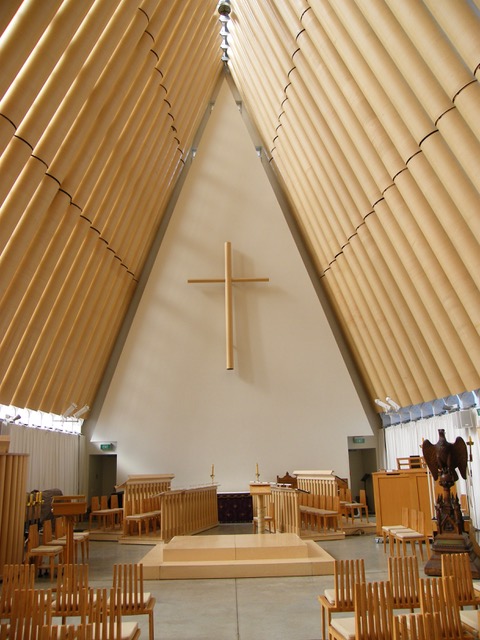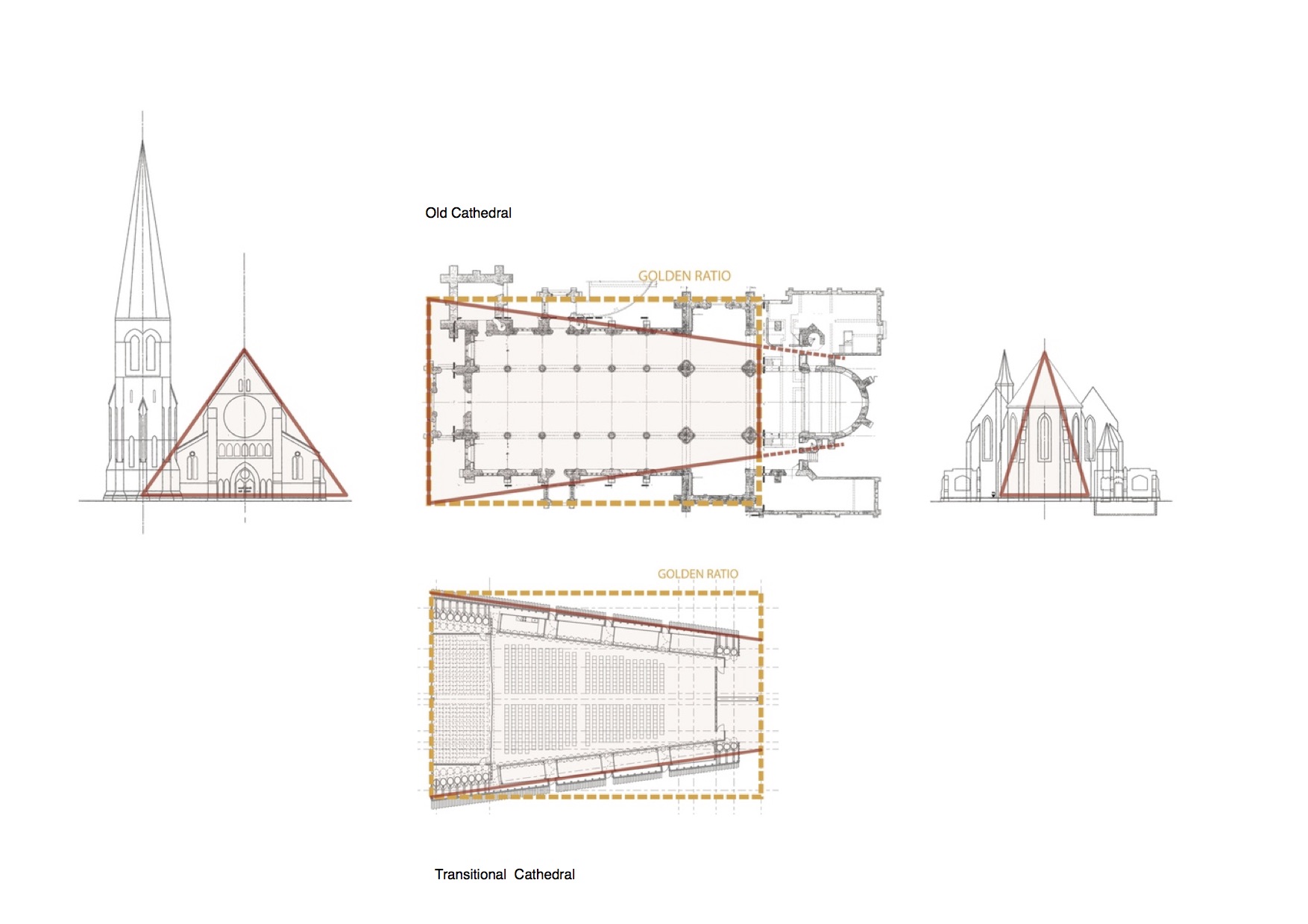This piece is written from ‘Fiddlesticks’, one of the busier bars in Christchurch, New Zealand, having visited a remarkable building today: the Transitional Cathedral, also known as the ‘Cardboard Cathedral’.I wasn’t sure what to expect to find as Christchurch continues to rebuild after the devastating earthquake in February 2011, and there is extra poignancy as I write as that awful anniversary is seven years ago to the day. 185 lives were lost and thousands more were changed forever. It was also a particular human tragedy for Japan, with 28 Japanese nationals among the dead; the largest national group affected after native New Zealanders. Most of the Japanese victims were students at an English language school in the Canterbury Television (CTV) building which collapsed, killing 115 people.To compound the problem for Christchurch, the city suffered a mass exodus after the earthquake and is still recovering on many levels. Despite its pedigree and rich natural assets, even the university has struggled to attract its student quota as the city has not been able to offer its usual resource or sustain its vibrancy.Many buildings were lost as a direct result of the quake and subsequent aftershocks, and many more have been demolished as a precaution since, as they were not originally designed to withstand seismic activity of this magnitude. The Anglican cathedral in Christchurch’s central square was the highest-profile architectural casualty, losing its landmark tower and iconic rose window. The broken building stands today surrounded by hoarding and with an uncertain future.Some time after the quake, cathedral staff read an article on Japanese architect Shigeru Ban, who had designed a replacement ‘Paper Church’, after the Great Hanshin earthquake destroyed the Takatori Church in Kobe in 1995. This was built with locally sourced materials and was dismantled after ten years and donated to a Catholic community in Taiwan, where it continues to serve as a place for worship. Ban used cardboard tubes, shipping containers and a lightweight skin in this and many other ’emergency architecture’ projects which draw on available materials for quick and temporary solutions.The architect was invited to Christchurch and came up with a quick solution, adopting similar technology as he had in Kobe. The new building has been constructed to 130% of the current New Zealand earthquake code, with the polished concrete floor slab one metre thick. The nave is lined with four shipping containers on each side, which have been modelled to provide a vestry, office, side chapel, kitchen, toilets and storage off the main worship space. They also provide anchor for the triangulated frame which gives the church its distinctive form. The cross-section and floor plan are derived from the proportions of the old cathedral, so that the roof rises to a height of 21m (70 feet) at the East (altar) end and the building width tapers towards this end too.As the roof beams rise and close in with the reducing plan, the roof has a subtle twist which is the result of the A-frame changing from a ‘flat A’ to a steeper one (both referenced from the old cathedral). This twist, or perhaps a double meaning of transition, is appreciated from without more than within, and inside the change in geometry is virtually imperceptible as perspective plays tricks with the eye as one looks towards the altar from the entrance. I enjoy these moments in buildings, where there is no song and dance about such intelligent moves; visitors either perceive it or they don’t, but there is no loss in overall experience.So, to the cardboard. Well, to the naked eye, it appears that the 96 cardboard tubes are acting together to support the huge triangular roof. They are 600mm in diameter, water resistant and flame retardant, and each is separated by 50mm gap from its neighbour. The tubes are individually very strong in compression and it is said that originally Ban wanted them to provide the actual structure (as in his previous work), but two circumstances changed that. The first was that local suppliers could not manufacture tubes of sufficient thickness (importing them was rejected) and the second was that it was decided that the building should be designed for a 50 year life as a permanent building for the parish of St John once the main cathedral was restored and brought back to life.Of course the cardboard could never have realistically acted as structure with these seismic demands. So, concealed inside each tube is a structural beam, connected at the base to the shipping container and at the apex to its opposite number. These steel connections are clearly visible, giving the whole assembly an honesty for those who care about such things. The roof cladding is polycarbonate, which glows at night through those 50mm gaps, and the rose window of the original cathedral has been re-interpreted in a striking new triangulated stained-glass assembly at the West end.In my view, the cardboard ultimately stands as a metaphor for the the temporary nature of the building. The actual material is somewhat redundant as an idea, yet it is highly symbolic in this particular solution. In the absence of new spaces and places which are under construction and will materialise in the next few years, the cathedral stands as a symbol of resilience and hope and is the most visited building in Christchurch as things stand. It can accommodate up to 700 people when opened up to capacity, but in day-to-day mode contains a shop and information point in its entrance foyer. Whilst it has been designed to provide replacement space for anglican worship, it extends its welcome to all faiths for quiet meditation.For those of us without direct experience, it is difficult to comprehend the effect of an earthquake on a busy working city. In addition to the physical and human impact, the loss of commercial and social confidence as the reality sinks in that it will take up to a decade to rebuild must be sobering. There are years where the chaos and disruption has no tangible payback as buildings and parks are the last to be constructed; first comes the often invisible basic infrastructure of sewers, storm drains, roads and bridges, all to new onerous codes and standards and at the cost of billions of dollars.Ban’s structure is best viewed from the leafy expanse of Latimer Square, but it also stands across the street from the site of the CTV building, where handwritten notes and photographs of those who died have until very recently fluttered on the temporary fencing. The intertwined experiences of loss, and the memory of Japan and New Zealand coming to each other’s aid, has tied the disasters and the countries together, especially in the minds of Christchurch locals.
The building’s innovative construction and its impact as a first major sign of new life seem to have captured the collective imagination, and it has become an enduring symbol of Christchurch’s revival whilst the city is slowly healed.
Cardboard Architecture
![]()
The Architect
Cardboard Architecture

About Richard Rose-Casemore
INVESTOR'S NOTEBOOK
Smart people from around the world share their thoughts
READ MORE >
THE MACRO VIEW
Recent financial news and how it connects across all asset classes
READ MORE >
TECHNOLOGY
Fintech, proptech and what it all means
READ MORE >

PODCASTS
Engaging conversations with strategic thinkers
READ MORE >
THE ARCHITECT
Some of the profession’s best minds
READ MORE >

RESIDENTIAL ADVISOR
Making money from residential property investment
READ MORE >
THE PROFESSOR
Analysis and opinion from the academic sphere
READ MORE >
FACE-TO-FACE
In-depth interviews with leading figures in the real estate/investment world.








